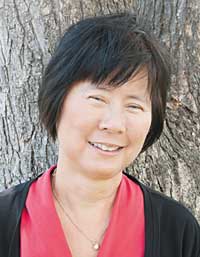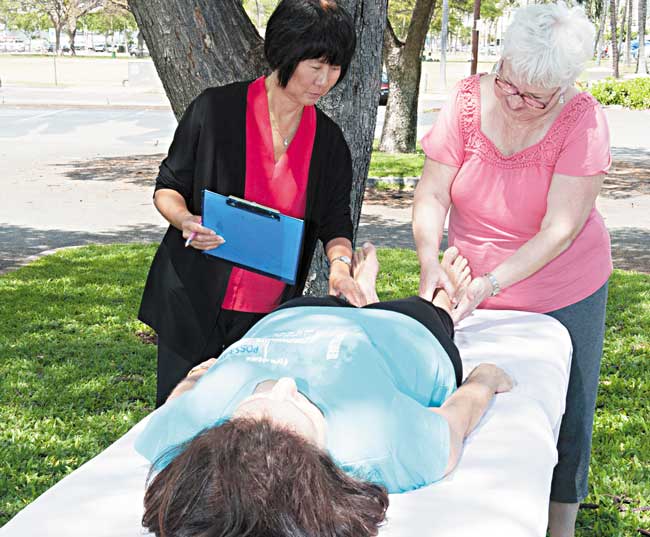At Last, A Fibromyalgia Cure

iFoG founder and president Annette Kam.
Nathalie Walker Photo
ANNETTE KAM
Founder and president of iFoG (informed Fibromyalgics on Guaifenesin)
Where did you receive your schooling and training?
I received my Bachelor of Science nursing degree in 1973 from University of Hawaii.
How long have you been a practicing nurse?
I have been an RN for almost 42 years, fibromyalgia support group leader for 15 years and president of iFoG for 12 years. Informed Fibromyalgics on Guaifenesin is a 501(c)(3) nonprofit organization that provides support to fibromyalgia sufferers. I am also the day shift charge nurse on the Mother Baby Care Unit at Kapiolani Medical Center.

Body mapper Vicki Mauck (right) shows iFoG founder and president Annette Kam typical “lumps and bumps” found on muscles and ligaments and fibromyalgia client Stephanie Uejio.
NWPhoto
What got you interested in working with fibromyalgia?
I have a personal interest in this debilitating syndrome, having suffered from it more than 25 years, not knowing what I had. Every test came back negative, to my frustration.
In 1998, I fell asleep driving and crashed my car. This triggered constant 24-7 pain and crushing fatigue. I was desperate to find answers and, two doctors later, I was finally diagnosed with fibromyalgia but spent the next two years trying 16 different promises of help, but to no avail.
In the summer of 2000, I found a book, What Your Doctor May Not Tell You About Fibromyalgia, by Dr. R. Paul St. Amand that changed my life forever and fired up a passion in me that has not dwindled in 15 years. St. Amand is an endocrinologist and assistant professor at UCLA Harbor. His book discusses a simple, inexpensive and harmless medication, guaifenesin, which when taken following a particular regimen (restricting certain dietary and topical products that many people use daily) would reverse fibromyalgia. Within six months, I went from a limping, pain-filled nurse to climbing the Great Wall of China, and a year later, competing in a national tennis tournament. God led me to start a support group, and the rest is history.
What is fibromyalgia?
Dr. St. Amand’s theory is that there is a buildup of phosphates in all our cells that causes all the problems of fibromyalgia. Our body cannot properly process phosphates, and an excess of phosphates causes disruption in every system of our body.
What are the symptoms?
Symptoms include, but are not limited to, chronic fatigue, pain, headaches, insomnia, stomach problems, irritable bladder, irritable bowel syndrome, dry eyes and mouth, blurry vision, concentration problems, depression and anxiety. These symptoms mystify not only the sufferer but also the physicians, and patients get shuffled from specialist to specialist until finally someone sees the whole picture.
How does a person acquire fibromyalgia?
It is hereditary, and there is a City of Hope (a research and treatment center for life-threatening diseases) study that is finding genetic markers that show evidence of this. We have three-generation families we are helping and have members who recall their grandparents or parents always in pain but were told they had arthritis.
What demographic does it affect?
If diagnosed before puberty, the ratio is 50 percent boys to 50 percent girls. If fibromyalgia presents after puberty, it’s found 85 percent in women and 15 percent in men. Many patients have their first symptoms in childhood, but these are often not recognized as fibromyalgia.
What treatments are available?
Doctors often give patients a trial of a low-dose antidepressant. If this does not improve their symptoms, then a stronger drug is added. If they have anxiety and or sleep issues, yet another medication is prescribed for that. As an April 2014 New England Journal of Medicine article on fibromyalgia states, “It is often necessary to use several of these classes of drugs together.”
The problem is that these medications only work for about a third of patients and their efficiency wanes with time. The medications also have a lot of side effects and also often just mask symptoms as the syndrome of fibromyalgia worsens over time.
Can you talk about how guaifenesin works?
The guaifenesin protocol was developed by St. Amand. Using guaifenesin gets to the root of the problem and does not just cover up the symptoms. The diagnosis is made, treatment is started and the progress of the patient is monitored by an objective physical exam called mapping where the calcium phosphate nodules can be felt. Guaifenesin causes the kidneys to excrete phosphates six times faster and, over a period of time, patients feel better as symptoms reverse and their mapping shows clearing. There are certain ingredients in products we ingest or use topically that must be avoided or the guaifenesin will be blocked from working. This is where our support group comes in. We walk our members through the protocol, educate them and monitor them regularly for progress.
Anything else you’d like to mention?
There is real hope for the more than 5 million who suffer from fibromyalgia and who think there is no way out of this dark abyss. I urge everyone who has fibro, who has a family member with fibro, who knows anyone with fibro or treats anyone with fibro to attend this free summit so lives can be changed.
iFoG and support groups from the Mainland, Canada and Australia are sponsoring a June 20 Hawaii Fibromyalgia Summit at the Japanese Cultural Center. The summit is free, thanks to donations from Kapiolani Medical Center and Pacific Medical Associates, among many others. Keynote speaker is San Francisco physician Melissa Congdon, who was trained by St. Amand and had suffered from fibromyalgia herself. (Her film, Guaifenesin Success Stories, can be seen at youtu.be/DtPPoOBeXTM.) Register for the summit at fibromyalgiahawaii.com. For more information, call 677- 8770.





